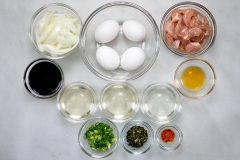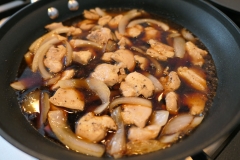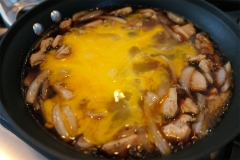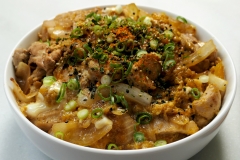Ingredients
For the dashi (yields 7 cups):
1 kombu (dried kelp), 5” x 6” piece
8 cups water, filtered
3 cups katsuobushi (dried & shaved bonito), lightly packed
For the oyakodon (serves two):
1/4 cup dashi
1/4 cup mirin
1/4 cup sake
1/8 cup soy sauce
4 eggs
1 tablespoon toasted sesame oil
1 pound boneless & skinless chicken thighs, cut into 1” pieces
1 tablespoon extra virgin olive oil
1/2 medium yellow onion, sliced
1 1/2 cups cooked short-grain white rice
2 tablespoons scallions, thinly sliced
1 tablespoon furikake (Japanese seasoning)
1/2 teaspoon shichimi togarashi (Japanese 7-spice blend)
Directions
To prepare the dashi, lightly clean the kombu with a damp towel. Be careful not to scrub the white film; it’s the source of kombu’s natural umami. In a small pot, soak the kombu in water for 30 minutes. If you have time, soak the kombu for five hours to extract more of its briny flavor.
Place the pot on medium heat and gently skim any white foam that appears. When the water barely starts to boil and small bubbles start to break the surface of the water, remove the kombu. If the water reaches a full boil, the kombu will make the dashi bitter.
Add the katsuobushi to the pot and bring the liquid to a boil. Gently skim the white foam that forms. Once it’s boiling, turn off the heat and allow the katsuobushi to steep for 15 minutes.
Place a sieve lined with cheesecloth or sturdy paper towels over a large bowl. Pour the dashi into the sieve and discard the katsuobushi. Dashi can be kept in the refrigerator for three days or stored in the freezer for up to three months.
To prepare the sauce for the oyakodon, add the dashi, mirin, sake and soy to a small bowl and mix well. Crack the eggs in another bowl and mix gently 10 times. Some of the egg whites should remain separate from the yolk. Set the sauce and eggs aside.
Add the sesame oil to a 10” saucepan set over medium-high heat. Add the chicken and sauté until cooked through, then set aside.
In the same saucepan, add the olive oil and sauté the onions. Once it’s golden brown, return the chicken to the pan and mix well. Reduce the heat to medium and add the sauce.
Once the chicken and onions return to a simmer, pour the eggs into the pan as evenly as possible. Allow the mixture to come to a boil, then cover and cook the eggs according to your preference. It will take about 3-5 minutes for runny eggs and 5-7 minutes for medium.
Scoop the cooked rice into a bowl and pour the chicken, onions and eggs on top. It’s okay if the mixture is a bit wet, it’ll coat the rice below. For extra umami, garnish with the scallions, furikake and shichimi togarashi.
Please note that this recipe includes a few ingredients that may be difficult to source, but most can be found in the Asian section of your local supermarket or online. You can substitute chicken or vegetable stock for the dashi, sliced nori (seaweed) for the furikake or red chili flakes for the shichimi togarashi.






